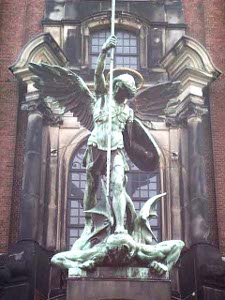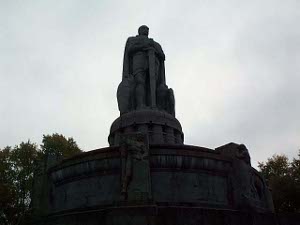Today we did the second half of the walking tour in our Hamburg guide book. There are fewer old buildings to see in Hamburg than Munich, because many of  Krameramtswohnungen
them were destroyed, either in the Great Fire of 1842, or in the bombing of 1943. As a result, one can see most of the historic buildings on foot in a couple of days. There are lovely little corners and alleys to explore, and each block brings new viewpoints. Always the mix of old and new buildings makes Hamburg an exciting and vibrant city.
Krameramtswohnungen
them were destroyed, either in the Great Fire of 1842, or in the bombing of 1943. As a result, one can see most of the historic buildings on foot in a couple of days. There are lovely little corners and alleys to explore, and each block brings new viewpoints. Always the mix of old and new buildings makes Hamburg an exciting and vibrant city.
Our first stop was the Krameramtswohnungen, found in the middle of a rather ordinary-looking block. One enters a narrow doorway through a hall to a hidden alley lined with houses dating from before 1700. They were built for the widows of small traders, but today they house restaurants and shops on the first floor; the upper stories are private apartments.
As we walked through a district of banks and office buildings, we kept noticing a striking dark-colored church tower, with a spiral staircase threading up toward the top of the steeple. We discovered that it is Michel, a city  St. Michael
landmark, actually St. Michael's church, bearing over the door a large statue of the saint killing Satan.
St. Michael
landmark, actually St. Michael's church, bearing over the door a large statue of the saint killing Satan.
The church was closed to tourists for Mass, and a large group of blind parishioners was being greeted and escorted in, one by one. We wondered whether that was an every Sunday event.
We then proceeded to the 34 meter tall heroic monument of Otto von Bismarck, the builder of a united Germany in the nineteeth century. The statue, in somber grey stone on top of a hill in the park, symbolizes Hamburg welcoming and protecting trade. Apparently ships coming in on the Elbe can see Bismarck and be comforted. The statue is so dominant we'd just be cowed!
In a side street past the Museum of Hamburg History were some residences restored to the same appearance they had during the lifetime of Johannes Brahms, who lived in the neighborhood.
Leaving high culture we walked down the Reeperbahn, a wide boulevard that  Otto von Bismarck
leads into the center of Hamburg's sin district in St. Pauli. On a Sunday morning it was about as quiet as it gets. St. Pauli is a mixture of theaters, porn shops, amusement arcades, MacDonald's, slot machine parlors, sex shows, bars, wax museums, movies, dance clubs, and a street full of bordellos. This was blocked off with a red painted fence, which stated that entry was denied to persons under 18 and women. (Bob reported that the "display windows" were all empty.)
Otto von Bismarck
leads into the center of Hamburg's sin district in St. Pauli. On a Sunday morning it was about as quiet as it gets. St. Pauli is a mixture of theaters, porn shops, amusement arcades, MacDonald's, slot machine parlors, sex shows, bars, wax museums, movies, dance clubs, and a street full of bordellos. This was blocked off with a red painted fence, which stated that entry was denied to persons under 18 and women. (Bob reported that the "display windows" were all empty.)
We walked down to the boat docks on the Elbe to finish our walk. The same musicians in sailor's clothes were playing their accordions and whistling songs for the tourists today, but at a different location. There are ten bridges to the docks with dozens of different alternatives for port tours, and crowds of people queuing up.
 800 years of history
800 years of history
We had just missed today's English language tour, so we decided to see the Rathaus. We got there about 11:30, and saw that the next English language tour was scheduled for 12:15.
We watched a clown trying to sweep up confetti on the plaza. The wind was blowing, and a small curly-headed boy kicked the pile of confetti over. A group watching him had assembled a couple of tables with baked goods and beverages. We couldn't quite figure out the relationship--were they fans? was it a bake sale? would something else be happening later? Passersby stopped for a moment or so, smiled, and continued on.
We went into the Rathaus a little before noon to get our tickets, and were told the next English language tour would be at 1:15. We decided to have lunch, thanked the lady, and told her we'd be back.
 Clown with confetti
Clown with confetti
As we strolled back in the direction of the hotel, we passed more street musicians. Today a young man in a tuxedo played classical violin music energetically. His stage setting included an elaborate black candelabra, with tall white candles, which he might light in the evening. We forgot to mention that yesterday we encountered a flute, violin and cello trio playing Mozart; today we also saw a bass clarinetist and a saxophonist. All within a few blocks of the hotel.
In Hamburg, as in the other German cities we've visited, the streets are most crowded on Saturday and Sunday, even though the stores are only open for half a day on Saturday and not at all on Sunday. People still walk about, window shopping or meeting friends, sitting in the park, feeding the birds (the sea gulls will catch the pieces of bread on the fly) and generally having a good time.
So are we.
 Krameramtswohnungen
them were destroyed, either in the Great Fire of 1842, or in the bombing of 1943. As a result, one can see most of the historic buildings on foot in a couple of days. There are lovely little corners and alleys to explore, and each block brings new viewpoints. Always the mix of old and new buildings makes Hamburg an exciting and vibrant city.
Krameramtswohnungen
them were destroyed, either in the Great Fire of 1842, or in the bombing of 1943. As a result, one can see most of the historic buildings on foot in a couple of days. There are lovely little corners and alleys to explore, and each block brings new viewpoints. Always the mix of old and new buildings makes Hamburg an exciting and vibrant city.
 St. Michael
St. Michael Otto von Bismarck
Otto von Bismarck 800 years of history
800 years of history Clown with confetti
Clown with confetti